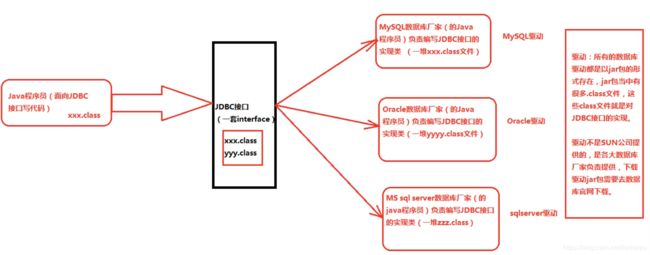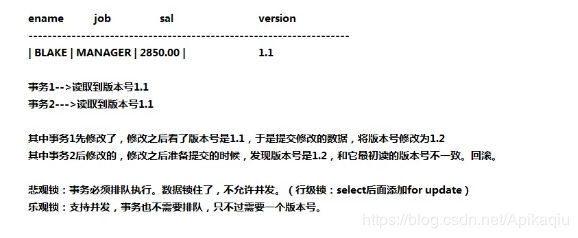JDBC
1、JDBC是什么?
Java DataBase Connectivity ( Java语言连接数据库)

2、JDBC的本质是什么?
JDBC是SUN公司制定的一套接口( interface )
java.sql.*; (这个软件包下有很多接口)
接口都有调用者和实现者。
面向接口调用、面向接口写实现类,这都属于面向接口编程。
为什么要面向接口编程?
解耦合:降低程序的耦合度,提高程序的扩展力。
多态机制就是非常典型的:面向抽象编程。(不要面向具体编程)
建议:
Animal a = new Cat() ;
Animal a = new Dog() ;
public void feed (Animal a){ //面向父类型编程。
不建议:
Dog d=new Dog();
Cat c=new Cat();
3、思考:为什么SUN制定一套JDBC接口呢?
因为每一个数据库的底层实现原理都不一样。
Oracle数据库有自己的原理。
MySQL数据库也有自己的原理。
MS SqlServer数据库也有自己的原理。
每一个数据库产品都有自己独特的实现原理。
JDBC的本质到底是什么?
一套接口
4、JDBC编程六步
第一步:注册驱动(作用:告诉Java程序,即将要连接的是哪个品牌的数据库)
第二步:获取连接(表示JVM的进程和数据库进程之间的通道打开了,这属于进程之间的通信,重量级的,使用完之后一定要通道)
第三步:获取数据库操作对象(专门执行sql语句的对象)
第四步:执行SQL语句(DQL DML…)
第五步:处理查询结果集(只有当第四步执行的是select语句的时候,才有这步。
第五步:处理查询结果集。
第六步:释放资源(使用完资源之后一定要关闭资源。Java和数据库属于进程间的通信,开启后一定要关闭。)
package com.hp.jdbc;
import java.sql.*;
public class Test01 {
public static void main(String[] args) {
try {
Class.forName("com.mysql.jdbc.Driver");
} catch (ClassNotFoundException e) {
e.printStackTrace();
}
}
public static class test{
public static void main (String[] args) {
Connection conn=null;
Statement stmt=null;
try{
//1、注册驱动
Driver driver = new com. mysql . jdbc.Driver(); //多态,父类型引用指向子类型对象。
DriverManager. registerDriver (driver) ;
//2、获取连接
/*
url:统一资源定位符(网络中某个资源的绝对路径)
https : / /www. baidu. com/ 这就是URL。
URL包括哪几部分?
协议
IP
PORT
资源名
http://182.61.200.7:80/index . html
http://通信协议
182.61.200.7服务器IP地址
80服务器上软件的端口
index.html是服务器上某个资源名
jdbc :mysql ://127.0.0.1:3306/bjpowernode
jdbc :mysql://协议
127.0.0.1 IP地址
3306 mysql数据库端口号
bjpowernode具体的数据库实例名。
说明: localhost和127.0.0. 1都是本机IP地址。
什么是通信协议,有什么用?
通信协议是通信之前就提前定好的数据传送格式。
数据包具体怎么传数据,格式提前定好的。
oracle的URL:
jdbc : oracle : thin: @localhost:1521 :orcl
*/
String url="jdbc:mysql://127.0.0.1:3306/bjpowernode";
String user="root";
String password="333";
conn=DriverManager.getConnection(url,user,password);
System.out.println("数据库连接对象 = "+ conn);
//3、获取数据库操作对象(Statement专门执行sql语句的)
stmt=conn.createStatement();
//4、执行sql
String sql = "insert into dept (deptno, dname,loc) values(50,'人事部', '北京')";
//专门执行DML语句的(insert delete update)
//返回值是“影响数据库中的记录条数"
int count = stmt.executeUpdate (sql) ;
//5、处理查询结果集
}catch (SQLException e) {
e.printStackTrace() ;
}finally{
//6、释放资源
//为了保证资源一定释放,在finally语句块中关闭资源
//并且要遵循从小到大依次关闭
//分别对其try. .catch
try{
if(stmt != null) {
stmt.close() ;}
}catch(SQLException e){
e.printStackTrace();
}
try{
if (conn != null) {
conn.close() ;
}
}catch(SQLException e){
e.printStackTrace();
}
}
}
}
}
注册驱动的另一种方式(重点)
public class Test03 {
public static void main(String[] args) {
try{
//1、注册驱动
//这是注册驱动的第一种方式
//DriverManager.registerDriver(new com.mysql.jdbc.Driver());
//这是注册驱动的第二种方式:常用的
//为什么这种方式常用?因为参数是一个字符串,字符串可以写到xxx.properties文件中
Class.forName("com.mysql.jdbc.Driver");
//2、获取连接
Connection conn=DriverManager.getConnection("jdbc:mysql://localhost:3306/bjpowernode","root","xqy2261579446");
}catch (SQLException e){
e.printStackTrace();
} catch (ClassNotFoundException e) {
e.printStackTrace();
}
}
}
jdbc.properties
driver=com.mysql.jdbc.Driver
url=jdbc:mysql://localhost:3306/bjpowernode
user=root
password=xxxxxxxxxxxxxx
package com.hp.jdbc;
//将连接数据库的所有信总配置到配置文件中
import java.sql.Connection;
import java.sql.DriverManager;
import java.sql.SQLException;
import java.sql.Statement;
import java.util.ResourceBundle;
public class Test04 {
public static void main(String[] args) {
//使用资源绑定器绑定属性配置文件
ResourceBundle bundle=ResourceBundle.getBundle("jdbc");
String driver=bundle.getString("driver");
String url=bundle.getString("url");
String user=bundle.getString("user");
String password=bundle.getString("password");
Connection conn=null;
Statement stmt=null;
try{
//1、注册驱动
Class.forName(driver);
//2、获取连接
conn=DriverManager.getConnection(url,user,password);
//3、获取数据库操作对象
stmt=conn.createStatement();
//4、执行SQL语句
//JDBC中的sql语句不需要提供分号结尾
//String sql="delete from dept where deptno=40";
String sql="update dept set dname='销售部',loc='天津' where deptno=20";
int count=stmt.executeUpdate(sql);
//System.out.println(count==1?"删除成功":"删除失败");
System.out.println(count==1?"更新成功":"更新失败");
}catch (SQLException e){
e.printStackTrace();
}catch (ClassNotFoundException e){
e.printStackTrace();
} finally{
//5、释放资源
if (stmt!=null){
try {
stmt.close();
} catch (SQLException e) {
e.printStackTrace();
}
}
if (conn!=null){
try {
conn.close();
} catch (SQLException e) {
e.printStackTrace();
}
}
}
}
}
5、处理查询结果集
public class Test05 {
public static void main(String[] args) {
Connection conn=null;
Statement stmt=null;
ResultSet rs=null;
try {
//1、注册驱动
Class.forName("com.mysql.jdbc.Driver");
//2、获取连接
conn= DriverManager.getConnection("jdbc:mysql://localhost:3306/bjpowernode","root","xqy2261579446");
//3、获取数据库执行对象
stmt=conn.createStatement();
//4、执行sql
String sql="select empno as a,ename,sal from emp";
// int executeUpdate (insert/delete/update)
// Resultset executeQuery (select)
rs=stmt.executeQuery(sql);//专门执行DQL语句的方法
//5、处理查询结果集
/*
boolean flag1 = rs.next() ;
//System.out.println(flag1) ; // true
if (flag1) {
//光标指向的行有数据:
//取数据
// getString() 方法的特点是:不管数据库中的数据类型是什么,都以string的形式取出。
String empno = rs.getString(1); // JDBC中所有下标从1开始。不是从0开始。
String ename = rs.getString(2);
String sal = rs.getString(3);
System.out.println(empno + "," + ename + "," + sal);
}
flag1 = rs.next() ;
if (flag1) {
//以下程序的12 3说的第几列。
String empno = rs.getString(1) ;
String ename = rs.getString(2) ;
String sal = rs.getString(3) ;
System. out.println (empno + "," + ename + ","+sal) ;
}
*/
while(rs.next()){
/*
String empno = rs.getString(1) ;
String ename = rs.getString(2) ;
String sal = rs.getString(3) ;
System. out.println (empno + "," + ename + ","+sal) ;
*/
/*
//以下不是以列的下标获取,以列的名字获取
String empno = rs.getString("a") ;//重点注意:列名称不是表中的列名称,是查询结果集的列名称。
String ename = rs.getString("ename") ;
String sal = rs.getString("sal") ;
System. out.println (empno + "," + ename + ","+sal) ;
*/
//除了可以以String类型取出之外,还可以以特定的类型取出。
int empno = rs.getInt(1) ;
String ename = rs.getString(2) ;
double sal = rs.getDouble(3) ;
System.out.println (empno + "," + ename + "," + (sal + 100)) ;
}
}catch (Exception e){
e.printStackTrace();
}finally {
//6、释放资源
if (rs!=null){
try {
rs.close();
} catch (SQLException e) {
e.printStackTrace();
}
}
if (stmt!=null){
try {
stmt.close();
} catch (SQLException e) {
e.printStackTrace();
}
}
if (conn!=null){
try {
conn.close();
} catch (SQLException e) {
e.printStackTrace();
}
}
}
}
}
6、模拟用户登录功能的实现。
6.1 程序运行的时候,提供一个输入的入口,可以让用户输入用户名和密码
用户输入用户名和密码之后,提交信息,java程序收集到用户信息
Java程序连接数据库验证用户名和密码是否合法
合法:显示登录成功
不合法:显示登录失败
public class login {
public static void main(String[] args) {
//初始化一个界面
Map<String,String> userLoginInfo=initUI();
//验证用户名和密码
boolean loginSuccess=login(userLoginInfo);
System.out.println(loginSuccess ? "登录成功":"登陆失败");
}
/**
* 用户登录
* @param userLoginInfo 用户登录信息
* @return false表示失败,true表示成功
*/
private static boolean login(Map<String,String>userLoginInfo){
//打标记
boolean LoginSuccess=false;
//JDBC代码
Connection conn=null;
Statement stmt=null;
ResultSet rs=null;
try {
//1、注册驱动
Class.forName("com.mysql.jdbc.Driver");
//2、建立连接
conn= DriverManager.getConnection("jdbc:mysql://localhost:3306/test","root","xqy2261579446");
//3、获取数据库操作对象
stmt=conn.createStatement();
//4、执行sql
String sql="select * from t_user where loginName='"+userLoginInfo.get("loginName")+"'and loginPwd='"+userLoginInfo.get("loginPwd")+"'";
//以上正好完成了sql语句的拼接,以下代码的含义是,发送sql语句给DBMS,DBMS进行sql编译
//正好将用户提供的“非法信息”编译进去。导致了原sql语句的含义被扭曲了。
rs=stmt.executeQuery(sql);
//5、处理结果集
if (rs.next()){
LoginSuccess=true;
}
} catch (Exception e) {
e.printStackTrace();
}finally {
//6、释放资源
if (rs !=null){
try {
rs.close();
} catch (SQLException e) {
e.printStackTrace();
}
}
if (stmt !=null){
try {
stmt.close();
} catch (SQLException e) {
e.printStackTrace();
}
}
if (conn !=null){
try {
conn.close();
} catch (SQLException e) {
e.printStackTrace();
}
}
}
return LoginSuccess;
}
/**
* 初始化用户界面
* @return 用户输入的用户名和密码等登录信息
*/
private static Map<String, String> initUI() {
Scanner s=new Scanner(System.in);
System.out.print("用户名:");
String loginName=s.nextLine();
System.out.print("密码:");
String loginPwd=s.nextLine();
Map<String,String> userLoginInfo=new HashMap<>();
userLoginInfo.put("loginName",loginName);
userLoginInfo.put("loginPwd",loginPwd);
return userLoginInfo;
}
}
当前程序存在的问题
用户名:fdsa
密码:fdsa’ or ‘1’='1
登录成功
这种现象被称为SQL注入
6.2 导致SQL注入的根本原因是什么?
用户输入的信息中含有sql语句的关键字,并且这些关键字参与sql语句的编译过程,
导致sq1语句的原意被扭曲,进而达到sql注入。
6.3 解决sql注入问题
只要用户提供的信息不参与SQL语句的编译过程,问题就解诀了。
即使用户提供的信息中含有SQL语句的关键字,但是没有参与编译,不起作用。
要想用户信息不参与SQL语句的编译,那么必须使用java.sql.Preparedstatement
Preparedstatement接口继承了java.sql.Statement
Preparedstatement是属于预编译的数据库操作对象。
Preparedstatement的原理是:预先对SQL语句的框架进行编译,然后再给SQL语句传“值”。
public class Test07 {
public static void main(String[] args) {
//初始化一个界面
Map<String,String> userLoginInfo=initUI();
//验证用户名和密码
boolean loginSuccess=login(userLoginInfo);
System.out.println(loginSuccess ? "登录成功":"登陆失败");
}
/**
* 用户登录
* @param userLoginInfo 用户登录信息
* @return false表示失败,true表示成功
*/
private static boolean login(Map<String,String>userLoginInfo){
//打标记
boolean LoginSuccess=false;
//单独定义变量
String loginName=userLoginInfo.get("loginName");
String loginPwd=userLoginInfo.get("loginPwd");
//JDBC代码
Connection conn=null;
PreparedStatement ps=null;//这里使用PreparedStatement (预编译的数据库操作对象)
ResultSet rs=null;
try {
//1、注册驱动
Class.forName("com.mysql.jdbc.Driver");
//2、建立连接
conn= DriverManager.getConnection("jdbc:mysql://localhost:3306/test","root","xqy2261579446");
//3、获取预编译的数据库操作对象
//SQL语句的框子。其中一个?表示一个占位符,一个?将来接收一个"值",注意:占位符不能使用单引号括起来。
String sql="select * from t_user where loginName= ? and loginPwd=?";//SQL语句框架
//程序执行到此处,会发送sql语句框给DBMS,然后DBMS进行sql语句的预先编译。
ps=conn.prepareStatement(sql);
//给占位符?传值(第1个问号下标是1,第2个问号下标是2,JDBC中所有下标从1开始。)
ps.setString(1,loginName);
ps.setString(2,loginPwd);
//4、执行sql
rs=ps.executeQuery();
//5、处理结果集
if (rs.next()){
LoginSuccess=true;
}
} catch (Exception e) {
e.printStackTrace();
}finally {
//6、释放资源
if (rs !=null){
try {
rs.close();
} catch (SQLException e) {
e.printStackTrace();
}
}
if (ps !=null){
try {
ps.close();
} catch (SQLException e) {
e.printStackTrace();
}
}
if (conn !=null){
try {
conn.close();
} catch (SQLException e) {
e.printStackTrace();
}
}
}
return LoginSuccess;
}
/**
* 初始化用户界面
* @return 用户输入的用户名和密码等登录信息
*/
private static Map<String, String> initUI() {
Scanner s=new Scanner(System.in);
System.out.print("用户名:");
String loginName=s.nextLine();
System.out.print("密码:");
String loginPwd=s.nextLine();
Map<String,String> userLoginInfo=new HashMap<>();
userLoginInfo.put("loginName",loginName);
userLoginInfo.put("loginPwd",loginPwd);
return userLoginInfo;
}
}
测试结果
用户名:fdsa
密码:fdsa’ or ‘1’='1
登陆失败
6.4解决SQL注入的关键是什么?
用户提供的信息中即使含有sql语句的关键字,但是这些关键字并没有参与编译。不起作用。
6.5、对比一下Statement和PreparedStatement
-Statement存在sql注入问题。
-Statement是编译一次执行一次。PreparedStatement是编译一次执行N次。
-PreparedStatement会在编译阶段做类型的安全检查。
综上所述,PreparedStatement会在编译阶段做类型的安全检查
6.6、什么情况下必须使用Statement?
业务方面要求必须支持SQL注入的时候
Statement支持SQL注入,凡是业务方面西药进行SQL语句拼接的,必须使用Statement
public class Test08 {
public static void main(String[] args) {
/*
//用户在控制台输入desc就是降序,输入asc就是升序
Scanner s=new Scanner(System.in);
System.out.println("请输入desc或asc,desc表示降序,asc表示升序");
System.out.println("请输入:");
String keywords=s.nextLine();
//执行SQL
Connection conn=null;
PreparedStatement ps=null;
ResultSet rs=null;
try {
Class.forName("com.mysql.jdbc.Driver");
conn= DriverManager.getConnection("jdbc:mysql://localhost:3306/bjpowernode","root","xqy2261579446");
//获取预编译的操作对象
String sql="select ename from emp order by ename ?";
ps=conn.prepareStatement(sql);
ps.setString(1,keywords);
//执行sql
rs=ps.executeQuery();
while (rs.next()){
System.out.println(rs.getString("ename"));
}
} catch ( Exception e) {
e.printStackTrace();
}finally {
if (rs!=null){
try {
rs.close();
} catch (SQLException e) {
e.printStackTrace();
}
}
if (ps!=null){
try {
ps.close();
} catch (SQLException e) {
e.printStackTrace();
}
}
if (conn !=null){
try {
conn.close();
} catch (SQLException e) {
e.printStackTrace();
}
}
}*/
//用户在控制台输入desc就是降序,输入asc就是升序
Scanner s=new Scanner(System.in);
System.out.println("请输入desc或asc,desc表示降序,asc表示升序");
System.out.println("请输入:");
String keywords=s.nextLine();
//执行SQL
Connection conn=null;
Statement stmt=null;
ResultSet rs=null;
try {
Class.forName("com.mysql.jdbc.Driver");
conn= DriverManager.getConnection("jdbc:mysql://localhost:3306/bjpowernode","root","xqy2261579446");
//获取数据库操作对象
stmt=conn.createStatement();
//执行sql
String sql="select ename from emp order by ename "+ keywords;
rs=stmt.executeQuery(sql);
while (rs.next()){
System.out.println(rs.getString("ename"));
}
} catch ( Exception e) {
e.printStackTrace();
}finally {
if (rs!=null){
try {
rs.close();
} catch (SQLException e) {
e.printStackTrace();
}
}
if (stmt!=null){
try {
stmt.close();
} catch (SQLException e) {
e.printStackTrace();
}
}
if (conn !=null){
try {
conn.close();
} catch (SQLException e) {
e.printStackTrace();
}
}
}
}
}
7、PreparedStatement完成insert delete update
public class Test09 {
public static void main(String[] args) {
Connection conn=null;
PreparedStatement ps=null;
try {
//1、注册驱动
Class.forName("com.mysql.jdbc.Driver");
//2、建立连接
conn= DriverManager.getConnection("jdbc:mysql://localhost:3306/bjpowernode","root","xqy2261579446");
//3、获取预编译的数据库操作对象
/*
String sql="insert into dept(deptno,dname,loc) values(?,?,?)";
ps=conn.prepareStatement(sql);
ps.setInt(1,60);
ps.setString(2,"销售部");
ps.setString(3,"上海");
*/
/* String sql="update dept set dname=?,loc=? where deptno=?";
ps=conn.prepareStatement(sql);
ps.setString(1,"研发一部");
ps.setString(2,"北京");
ps.setInt(3,60);*/
String sql="delete from dept where deptno = ?";
ps=conn.prepareStatement(sql);
ps.setInt(1,60);
//4、执行SQL
int count=ps.executeUpdate();
System.out.println(count);
} catch (Exception e) {
e.printStackTrace();
}finally {
//6、释放资源
if (ps !=null){
try {
ps.close();
} catch (SQLException e) {
e.printStackTrace();
}
}
if (conn !=null){
try {
conn.close();
} catch (SQLException e) {
e.printStackTrace();
}
}
}
}
}
10、JDBC事务机制
1、JDBC中的事务是自动提交的,什么是自动提交?
只要执行任意一条DML语句, 则自动提交一次。这是JDBC默认的事务行为。
但是在实际的业务当中,通常都是N条DML语句共同联合才能完成的,必须
保证他们这些DML语句在同一个事务中同时成功或者同时失败。
2、以下程序先来验证一下JDBC的事务是否是自动提交机制!
测试结果:JDBC中只要执行任意一条DML语句,就提交一次。
public class Test10 {
public static void main(String[] args) {
Connection conn=null;
PreparedStatement ps=null;
try {
//1、注册驱动
Class.forName("com.mysql.jdbc.Driver");
//2、建立连接
conn= DriverManager.getConnection("jdbc:mysql://localhost:3306/bjpowernode","root","xqy2261579446");
//3、获取预编译的数据库操作对象
String sql="update dept set dname = ? where deptno = ?";
ps=conn.prepareStatement(sql);
//第一次给占位符传值
ps.setString(1,"x部门");
ps.setInt(2,30);
int count=ps.executeUpdate();//执行第一条UPDATE语句
System.out.println(count);
//重新给占位符传值
ps.setString(1,"y部门");
ps.setInt(2,20);
count=ps.executeUpdate();//执行第二条UPDATE语句
System.out.println(count);
} catch (Exception e) {
e.printStackTrace();
}finally {
//6、释放资源
if (ps !=null){
try {
ps.close();
} catch (SQLException e) {
e.printStackTrace();
}
}
if (conn !=null){
try {
conn.close();
} catch (SQLException e) {
e.printStackTrace();
}
}
}
}
}
import java.sql.Connection;
import java.sql.DriverManager;
import java.sql.PreparedStatement;
import java.sql.SQLException;
/**
* sql脚本
* drop table if exists t_act;
* create table t_act(
* actno int,
* balance double(7,2)//注意:7表示有效数字的个数(从左往右第一个不是0的数字开始成为有效数字),2表示小数位的个数
* );
* insert into t_act(actno,balance) values(111,20000);
* insert into t_act(actno,balance) values(222,0);
* commit;
* select * from t_act;
*
* 重点代码:
* conn.setAutoCommit(false);
* conn.commit();
* conn.rollback();
*/
public class Test11 {
public static void main(String[] args) {
Connection conn = null;
PreparedStatement ps = null;
try {
//1、注册驱动
Class.forName("com.mysql.jdbc.Driver");
//2、建立连接
conn = DriverManager.getConnection("jdbc:mysql://localhost:3306/bjpowernode", "root", "xqy2261579446");
//将自动提交机制修改为手动提交
conn.setAutoCommit(false);//开启事务
//3、获取预编译的数据库操作对象
String sql = "update t_act set balance = ? where actno = ?";
ps = conn.prepareStatement(sql);
//给?传值
ps.setDouble(1, 10000);
ps.setInt(2, 111);
int count = ps.executeUpdate();
// String s=null;
// s.toString();
//给?传值
ps.setDouble(1, 10000);
ps.setInt(2, 222);
count += ps.executeUpdate();
System.out.println(count == 2 ? "转账成功" : "转账失败");
//程序能够走到这里说明以上程序没有异常,事务结束,手动提交数据
conn.commit();//提交事务
} catch (Exception e) {
if (conn !=null){
try {
conn.rollback();//回滚事务
} catch (SQLException ex) {
ex.printStackTrace();
}
}
e.printStackTrace();
} finally {
//6、释放资源
if (ps != null) {
try {
ps.close();
} catch (SQLException e) {
e.printStackTrace();
}
}
if (conn != null) {
try {
conn.close();
} catch (SQLException e) {
e.printStackTrace();
}
}
}
}
}
11、JDBC工具类,简化JDBC编程
public class DBUtil {
/**
* 工具类的构造方法都是私有的
* 因为工具类当中的方法都是静态的,不需要new对象,直接用类名调用
*/
private DBUtil(){
}
//静态代码块在类加载的时候执行,并且只执行一次
static {
try {
Class.forName("com.mysql.jdbc.Driver");
} catch (ClassNotFoundException e) {
e.printStackTrace();
}
}
/**
* 获取数据库连接对象
* @return 连接对象
* @throws SQLException
*/
public static Connection getConnection() throws SQLException {
return DriverManager.getConnection("jdbc:mysql://localhost:3306/bjpowernode","root","xqy2261579446");
}
/**
* 关闭资源
* @param conn 连接对象
* @param stmt 数据库操作对象
* @param rs 结果集
*/
public static void close(Connection conn, Statement stmt, ResultSet rs){
if (rs!=null){
try {
rs.close();
} catch (SQLException e) {
e.printStackTrace();
}
}
if (stmt!=null){
try {
stmt.close();
} catch (SQLException e) {
e.printStackTrace();
}
}
if (conn !=null){
try {
conn.close();
} catch (SQLException e) {
e.printStackTrace();
}
}
}
}
12、java中的模糊查询
public class Test12 {
public static void main(String[] args) {
Connection conn=null;
PreparedStatement ps=null;
ResultSet rs=null;
try {
//获取连接
conn= DBUtil.getConnection();
//获取预编译的数据库操作对象
//错误写法
/*String sql="select ename from emp where ename like '_?%'";
ps=conn.prepareStatement(sql);
ps.setString(1,"A");*/
String sql="select ename from emp where ename like ?";
ps=conn.prepareStatement(sql);
ps.setString(1,"_A%");
rs=ps.executeQuery();
while (rs.next()){
System.out.println(rs.getString("ename"));
}
} catch (Exception e) {
e.printStackTrace();
}finally {
//释放资源
DBUtil.close(conn,ps,rs);
}
}
}
13、乐观锁和悲观锁
/**
* 这个程序开启一个事务,这个事务专门进行查询,并且使用行级锁/悲观锁,
* 锁住相关的记录
*/
public class Test13 {
public static void main(String[] args) {
Connection conn=null;
PreparedStatement ps=null;
ResultSet rs=null;
try {
conn= DBUtil.getConnection();
conn.setAutoCommit(false);
String sql="select ename,job,sal from emp where job = ? for update";
ps=conn.prepareStatement(sql);
ps.setString(1,"MANAGER");
rs=ps.executeQuery();
while (rs.next()){
System.out.println(rs.getString("ename")+","+rs.getString("job")+","+rs.getDouble("sal"));
}
conn.commit();
} catch (SQLException e) {
if (conn != null){
try {
//回滚事务(事务结束)
conn.rollback();
} catch (SQLException ex) {
ex.printStackTrace();
}
}
e.printStackTrace();
}finally {
DBUtil.close(conn,ps,rs);
}
}
}
/**
* 修改被锁定的记录
*/
public class Test14 {
public static void main(String[] args) {
Connection conn=null;
PreparedStatement ps=null;
try {
conn= DBUtil.getConnection();
conn.setAutoCommit(false);
String sql="update emp set sal =sal * 1.1 where job = ?";
ps.setString(1,"MANAGER");
int count=ps.executeUpdate();
System.out.println(count);
conn.commit();
} catch (SQLException e) {
if (conn !=null){
try {
conn.rollback();
} catch (SQLException ex) {
ex.printStackTrace();
}
}
e.printStackTrace();
}finally {
DBUtil.close(conn,ps,null);
}
}
}
在test13中提交事务之前设置断点,test13不结束,test14无法执行完成,只有test13结束了,test14才乐意执行完。验证了悲观锁一旦锁上,想要修改记录或者执行其它操作需要排队等待。

